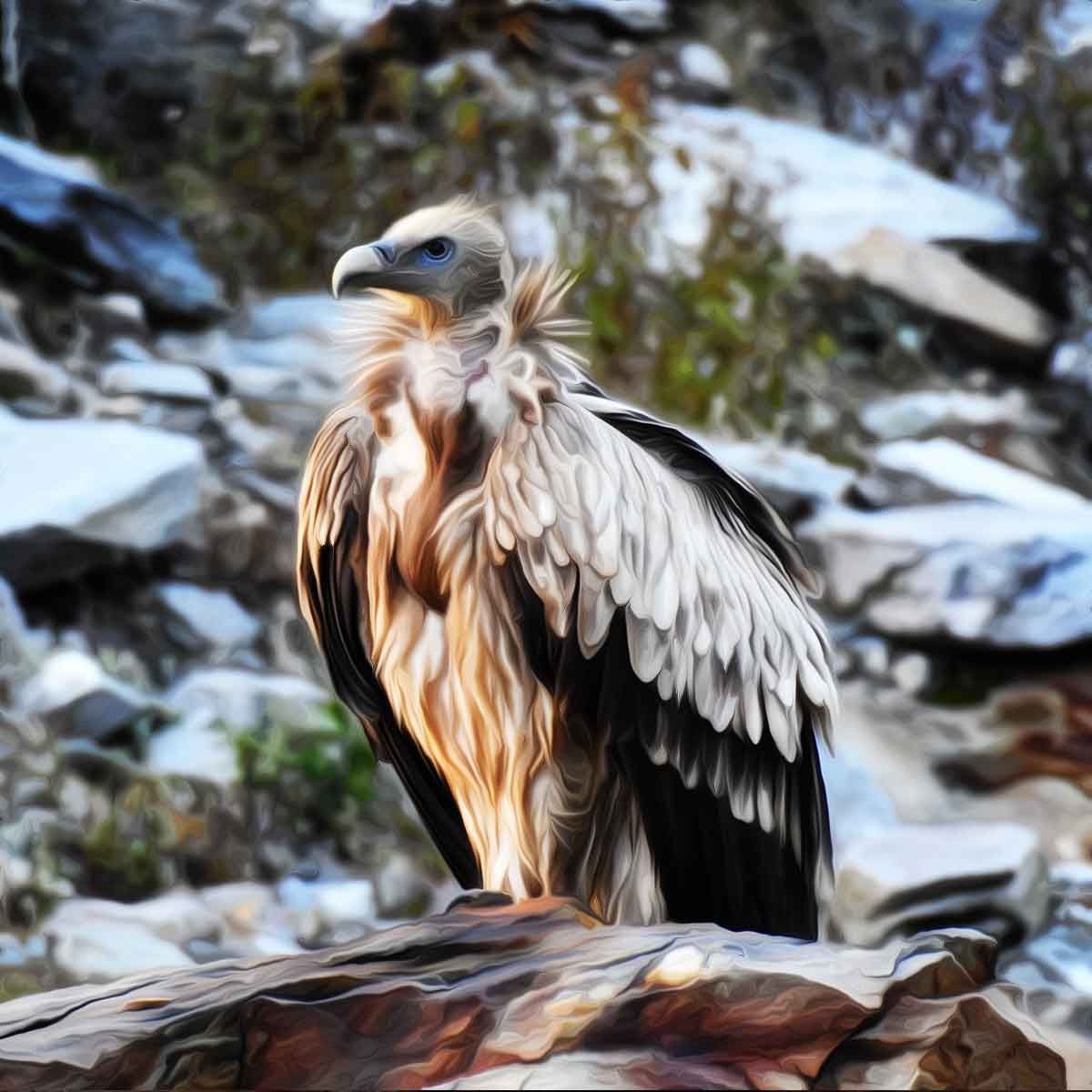More Coverage
Twitter Coverage
Satyaagrah
Written on
Satyaagrah
Written on
Satyaagrah
Written on
Satyaagrah
Written on
Satyaagrah
Written on
JOIN SATYAAGRAH SOCIAL MEDIA
"A mystic Himalayan Griffon is a bird who separates heaven and earth with his wings": A rare vulture was captured in Eidgah cemetery of Kanpur's Colonelganj, locals handed it over to Forest Department after capturing it, had been there for a week

New Delhi: A rare Himalayan Griffon Vulture was rescued by locals from the Eidgah cemetery of Kanpur's Colonelganj and later handed over to the Uttar Pradesh Forest Department, as reported by the news agency ANI. The incident has created a lot of buzz on the Internet. People in the Kanpur village were not able to hold back their excitement after the incident that happened over the weekend.
|
The young population at the village were posing with the scavenger bird, pulling its wings to a full stretch to show off their capture. According to the experts, the Griffon Vulture is one the biggest bird species found in the Himalayas with a wing span of over '6-feet'.
"Himalayan Griffon vultures are now nearly threatened. They are called ecosystem engineers," says Indian Forest Service officer Praveen Kaswan in one of his tweets last year when he rehabilitated one of the rare birds. Kaswan took a look at the visuals shared on Twitter also by ANI and confirmed: "It looks like a Himalayan Griffon Vulture. Sub-adults are migratory, adults live on higher reaches. They can live upto 40-45 years of age."
Their large wingspan helps these vultures soar high in the sky searching for carcasses on the ground. It is a documented fact that by feeding on the carcasses, vultures prevent diseases from spreading to humans. The locals at the Kanpur Eidgah, who played with the rare species were lucky to capture the bird with less energy as it appeared subdued, ANI reported.
There was hardly any counter from the bird as the people around pulled at its magnificent wings or cajoled it as a baby in their arms. In winter the Himalayan Griffon Vultures are seen in Terai and adjoining areas -- a kind of local migration for the species, experts added.
A local from the Kanpur village, Mohd. Safiq, said, "The vulture we finally managed to capture had been here for a week. We tried to catch it but didn't succeed. Finally, we captured it when it came down," as quoted by ANI.
Talking about the rare sighting, the excited youngster said he often heard there were now fewer vultures in the country and wondered if prize money has been announced for capturing vultures. Safiq said, "We handed over the vulture to the Forest Department in the presence of the police."
|
Himalayan griffon vulture
The Himalayan vulture (Gyps himalayensis) or Himalayan griffon vulture is an Old World vulture native to the Himalayas and the adjoining Tibetan Plateau. It is one of the two largest Old World vultures and true raptors. It is listed as Near Threatened on the IUCN Red List.
This is a huge vulture, and is perhaps the largest and heaviest bird found in the Himalayas. It is the largest of the species in the Gyps genus, seemingly averaging larger in every method of measurement than its relatives. Adults have a ruff that is long and pale brown with white streaks. The ruff feathers are long and spiky. The head is covered in down which is yellowish in adults but whitish in immature vultures.
The underside and under-wing coverts are quite pale brown or buff, being almost white in some specimens. The legs are covered with buffy feathers and the feet can vary from greenish grey to white. The upperside is unstreaked, pale buff with the tail quills, outer greater coverts and wing quills being a contrasting dark brown. The inner-secondaries have paler tips.
The pale blue facial skin is lighter than the dark blue in Gyps fulvus with this species having a yellowish bill. In flight the long fingers are splayed and there is a pale patagial stripe on the underwing. The wing and tail feathers are dark and contrast with the pale coverts and body, one of the best methods to distinguish this species from the slightly smaller griffon vulture. The feathers on the body have pale shaft streaks.
They are distinguished from the Indian vulture (G. indicus), which can somewhat similar in color by being much larger with a stouter, more robust bill. Younger birds have a pale parts to the bill and tend to have buffy-white streaks on the scapulars and wing coverts contrasting with dark brown underparts. They are similar in size to the cinereous vulture (Aegypius monachus), which has a slightly shorter overall length but in large specimens can weigh more than the Himalayan vulture.
Weight in Himalayan vultures can range from reportedly as little as 6 kg lb abbr=on to as much as 12.5 kg lb abbr=on. A field study estimated an average of 9 kg lb abbr=on for the Himalayan vulture, but weights can vary with conditions from 8 - 12 kg lb abbr=on. The wingspan of birds varies greatly depending on the method used to measure them and published measurements vary from 2.56 to 3.1 m ft abbr=on, a similar wingspan range as a cinereous vulture.
The Himalayan vulture lives mainly in the higher regions of the Himalayas, the Pamirs, Kazakhstan and on the Tibetan Plateau, with northwestern limits of the breeding range being in Afghanistan and southern limits in Bhutan. Juvenile birds may however disperse further south, and vagrants have been recorded in Thailand, Burma, Singapore and Cambodia.
The Himalayan vulture perches on crags, favourite sites showing white marks from regular defecation. They tend to not range below an elevation of 1215 m ft abbr=on. Himalayan vultures often bask in the sun on rocks. They soar in thermals and are not capable of sustained flapping flight. Flocks may follow grazers up the mountains in their search for dead animals. This vulture makes a rattling sound when descending on a carcass and can grunt or hiss at roosts or when feeding on carrion.
They have been recorded eating carrion exclusively, some which is fed on even when putrid. On the Tibetan Plateau 64% of their diet is obtained from dead domestic yak (Bos grunniens). They feed on old carcasses sometimes waiting a couple of days near a dead animal. They disdain offal, which is readily eaten by other vultures, and instead typically eat only fleshy parts. Historically, Himalayan vultures regularly fed on human corpses left out on Celestial burial grounds.
This species is fairly contentious around other scavengers and typically dominates other meat-eaters at carrion, though is subservient to gray wolves (Canis lupus), snow leopards (Panthera uncia) and cinereous vultures at carcasses. In a large party, these vultures can reportedly strip a human or sheep carcass of all meat in 30 minutes and do the same to a yak carcass in roughly 120 minutes. Himalayan vultures have been observed feeding on pine (Pinus roxburghii) needles, an unexplained behaviour that cannot be for obtaining nutrition.
|
Threats
Himalayan vultures are susceptible to toxicity induced by diclofenac, a drug whose residues in domestic animal carcasses has led to rapid declines in populations of other Gyps vultures across Asia. The Himalayan griffon vulture populations have however not shown signs of rapid decline although reductions in nesting birds have been noted in some parts of its range in Nepal.
 Support Us
Support Us
Satyagraha was born from the heart of our land, with an undying aim to unveil the true essence of Bharat. It seeks to illuminate the hidden tales of our valiant freedom fighters and the rich chronicles that haven't yet sung their complete melody in the mainstream.
While platforms like NDTV and 'The Wire' effortlessly garner funds under the banner of safeguarding democracy, we at Satyagraha walk a different path. Our strength and resonance come from you. In this journey to weave a stronger Bharat, every little contribution amplifies our voice. Let's come together, contribute as you can, and champion the true spirit of our nation.
 |  |  |
| ICICI Bank of Satyaagrah | Razorpay Bank of Satyaagrah | PayPal Bank of Satyaagrah - For International Payments |
If all above doesn't work, then try the LINK below:
Please share the article on other platforms
DISCLAIMER: The author is solely responsible for the views expressed in this article. The author carries the responsibility for citing and/or licensing of images utilized within the text. The website also frequently uses non-commercial images for representational purposes only in line with the article. We are not responsible for the authenticity of such images. If some images have a copyright issue, we request the person/entity to contact us at This email address is being protected from spambots. You need JavaScript enabled to view it. and we will take the necessary actions to resolve the issue.
Related Articles
- "An animal's eyes have the power to speak a great language": Shoebill - large, elusive, stalk-like bird with prehistoric appearance due to oversized shoe-shaped beak, usually silent but clatter their bills loudly during greetings sounds like a machinegun
- “An animal’s eyes have the power to speak a great language”: Rare Himalayan Lynx found in Ladakh region of India, they occur throughout northern slopes of Himalayas and has been reported both from thick scrub woodland & barren, rocky areas above tree line
- "A horse gallops with his lungs, perseveres with his heart, and wins with his character”: Shubhrak seeing his master in danger became uncontrollable and threw Qutubuddin on the ground, stomped his chest and head with mighty hooves killing him on the spot
- "Symbols are powerful because they are the visible signs of invisible realities": Real Sindoor comes from a tree, a low-height tree that finds mention in our scriptures. Seeds from the tree are crushed to make fine powder and were used by Sita and Hanuman
- “Birds teach a great life lesson. All you have to do is listen to their song”: Chilika in Odisha is the largest brackish water lake in Asia and great attraction for tourists for fishing, bird watching & boating, indigenous & migratory birds are a delight
- “You can’t make a zebra by painting stripes on a horse”: Deep in the heart of Congo is a curious creature bit like a horse, a bit like a giraffe "Okapi", an artiodactyl mammal that is endemic to Africa, the Okapi is to the Congo what the Panda is to China
- In one of the rarest incidents wild mother elephant gave birth to twins in the Bandipur Tiger Reserve: Soon after the birth, the two toddlers joined their mother back in the herd
- “Kerala is superbly seen from a saddle, or with a paddle. No hour of life is wasted there”: Alleppey, also known as Alappuzha, a picturesque town of #Kerala famous for its backwaters and serene beauty has fascinated tourists for its floating houses
- “You need mountains, long staircases don’t make good hikers”: Kalavantin Durg - one of the steepest fortresses in Maharashtra 2,300 feet high trek up this fort is called ‘Climb to Heaven’ because it involves rugged terrain & climbing narrow rock-cut steps
- "Three may keep a secret, if two of them are dead": Fifty shades of Auroville - a town in India where there is no religion, politics or money, City of Dawn claims its purpose is to enable men & women of all countries to live in peace & progressive harmony
- “A river seems like a magic thing, moving, living part of the earth itself”: India to gain a huge boost in inland water transportation by launching the world's Longest River Cruise, MV Ganga Vilas, sailing from Varanasi to Dibrugarh across 27 river system
- “There’s only one way to tackle life, enjoy a day at beach, and jump into a Great Lake: Headfirst!”: 'LAKES' to 'LAYOUT', how lake areas transformed into residential & commercial entities, educational institutes, bus stands, stadiums etc. and at what cost
- "Each species is a masterpiece, a creation assembled with extreme care & genius": Ghost of the mountains | Snow Leopard, one of the most agile hunters on earth is an elusive mammal species of cat family, top-predator of Central Asia & Indian Himalaya
- Mysterious death of Pandit Deen Dayal Upadhyaya, whose growing popularity was a threat to Congress
- "Everything depends on this: a fathomless sinking into a fathomless nothingness": Joshimath sinking - 10 crore people visit Uttarakhand a year, how much can it take say experts, Nainital, Mussoorie, Dharchula and several towns could face similar disaster




























